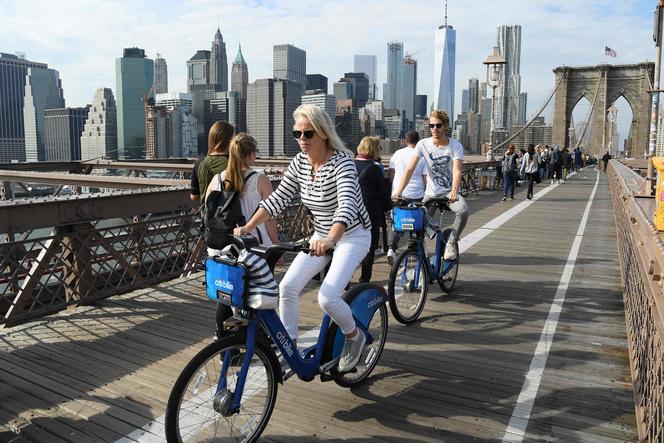
Booming bike paths and shared bikes, free lessons for cyclists: more and more New Yorkers are getting on their bikes in the shadow of skyscrapers, witnessing the efforts of the first American city to catch up in this domain.
For a long time, this metropolis of 8.5 million inhabitants, with the densest public transport network in the United States, was content to observe from afar the development of cycling in European capitals. But since 2013, when the Citi Bike self-service bicycle network was launched, the American financial capital has embraced the cause of the little queen like never before.
“The city has come a long way, it is now much more committed to the development of cycling”, explains Rich Conroy, one of the managers of the Bike New York association, dedicated to the safety of cyclists. “People realize that the city can no longer grow by adding cars, there is no more room. We have to develop in an economically and environmentally sustainable way, confront our environmental and health problems and make the city attractive to a younger workforce ”, he said.
A craze for self-service bicycles
A recent study by the city hall’s transportation department shows how far we’ve come: in early 2017, 778,000 New Yorkers – or 12% of the adult population – said they cycle regularly, 250,000 more than five years ago. .
Citi Bike bikes embody this craze: the number of users of the service continues to increase, reaching 245,000 year-round at the end of September, against 200,000 a year earlier. Taking advantage of 450 kilometers of cycle paths developed over the past five years, some 86,000 New Yorkers have adopted the bicycle as their primary mode of transportation. Making New York the fastest growing American metropolis in the world.
Soe Thi Ha, 29, who cycles 20 kilometers every day between Manhattan and her Brooklyn apartment, is one of the new bike addicts. “I saw that all my friends were getting into it, all the cycle paths, I no longer saw any excuse not to take part in it”, says this specialist in marketing psychology, Burmese by origin. “It changed my life”, he said. “I would now like to cycle around the world”.
Insufficient security, say many residents
Yet, as enthusiastic as they are, and encouraged by an increasingly failing metro, many residents deplore insufficient security. Bridges, tunnels, one-way avenues congested by buses, trucks or large 4 × 4 vehicles, potholes by the hundreds of thousands: pedaling from one district to another of this city is far from being easy. Thus, 18 cyclists were killed in 2016, and nearly 5,000 were injured.
“I love cycling, I have always done it, but I’m very scared in the streets of New York”, says Ilene Richman, 53, a Brooklyn resident. “Everyone I know who rides a bike has been in an accident. It’s scary. “
When eight people died on October 31 in a ram truck bombing in Manhattan, some recalled that other fatal accidents had already occurred on this bike path that runs along the Hudson, on which motorists can easily encroach.
To overcome his fear, Mme Richman signed up for free Bike New York classes, which has skyrocketed since 2012 to 17,000 students last year.
Supported by the town hall, the association teaches the safest gestures: use the bell abundantly, respect fires or howl ” Me ! » to signal its presence to motorists and pedestrians. But in a country used to favoring the car, it is above all the training of motorists that is lacking and that must be “Greatly improved”, recognizes Mr. Conroy.
Controversy over the electric bike
Another weak point: electric bicycles, currently banned in New York. Surprising illegality for a metropolis that wants to be at the cutting edge of technology. And which is explained by the hostility of some of the inhabitants, who fear being run over by the electric bicycles of restaurant delivery men, omnipresent in the city.
The town hall is therefore slowing down the adoption of legislation adapted to different types of electric bikes, explains Morgan Lommele, of the People For Bikes association. And the New York police officers fined the thousands of deliverers in “e-bikes” (“eletric bikes”, electric bicycles), with fines of up to $ 500, even sometimes with the confiscation of the bicycle.
The growing controversy, Morgan Lommele hopes that the town hall, faithful to its commitment to cycling, will eventually change its mind: “Talking to all users of electric bikes is not going to make them disappear, especially in an e-bike industry that is growing by 80% per year. “
–


